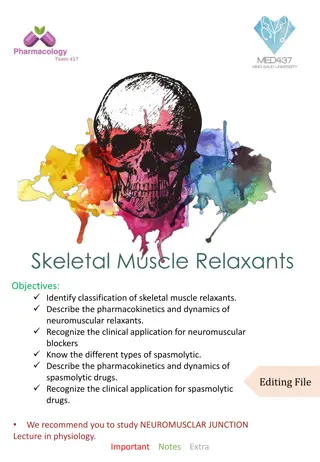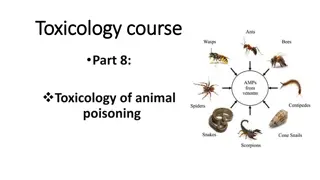Neurologic Disorder
Structural divisions of the central and peripheral nervous systems, learn about neuron anatomy, the neuromuscular junction, and the role of neurotransmitters. Includes information on Acetylcholine, Norepinephrine, Dopamine, and Serotonin.
0 views • 24 slides
Skeletal Muscle Relaxants and Neuromuscular Blockade
Skeletal muscle relaxants are used to induce muscle relaxation during surgeries. Neuromuscular blocking agents act at the neuromuscular junction. These drugs can either peripherally reduce muscle tone or centrally cause muscle paralysis. Different types of muscle relaxants are classified based on th
6 views • 23 slides
The Origins of the Cold War and U.S.-Soviet Antagonism
Amid post-World War II developments and contrasting ideologies, the Cold War emerged, marked by Yalta and Potsdam Conferences, the Truman Doctrine, the Marshall Plan, the Berlin Blockade, NATO's formation, and more. Various perspectives exist on the roots of U.S.-Soviet tensions, with the Soviet vis
1 views • 16 slides
Understanding Cold War Tensions: Causes, Events, and Decisions
Explore the complex dynamics of the Cold War era through a series of questions and analyses. Uncover the factors behind the hostile relations between the USA and the Soviet Union from 1945 to 1949, including the Berlin Blockade and key conferences like Yalta and Potsdam. Delve into the breakdown of
0 views • 33 slides
Understanding Strength-Duration (SD) Curve: A Neuromuscular Diagnostic Test
Strength-Duration (SD) curve is a diagnostic test assessing neuromuscular integrity by measuring the relationship between stimulus strength and duration. It helps in electro-diagnosis of peripheral nervous system disorders and evaluates nerve degeneration and regeneration. The curve is obtained by p
2 views • 17 slides
Understanding Local Anesthetics: Mechanism, Characteristics, and Pharmacokinetics
Local anesthetics (LAs) block nerve impulse conduction effectively for pain management without motor blockade. Their chemistry, including lipophilic groups and ionizable groups, contributes to their efficacy. LAs have rapid onset, long duration, reversibility, and minimal side effects. Pharmacokinet
0 views • 30 slides
Skeletal Muscle Relaxants: Classification, Pharmacokinetics, and Clinical Applications
Skeletal muscle relaxants encompass different types, including neuromuscular blockers, spasmolytic drugs, and peripherally-acting agents. They are classified based on mechanisms of action and play crucial roles in inducing skeletal muscle relaxation for various clinical applications. Understanding t
3 views • 12 slides
Understanding Animal Venom and Snake Classification in Toxicology
Animal venom, particularly snake venom, contains various toxins that can have detrimental effects on the body. Different types of snake venom target specific systems, such as neurotoxic venom affecting neuromuscular junctions and hemotoxic venom impacting the cardiovascular system. Understanding the
4 views • 27 slides
Understanding Flexibility: Types, Methods, and Benefits
Flexibility is the ability of joints to move within their maximum range, crucial for overall health and sports performance. It can be passive or active, and there are various methods to enhance it such as ballistic, static stretching, dynamic stretching, and proprioceptive neuromuscular facilitation
0 views • 8 slides
Berlin Airlift: A Major Cold War Confrontation
The Berlin Airlift was a pivotal event during the Cold War where the Western allies launched an unprecedented airlift operation to ensure the survival of West Berlin in the face of a Soviet blockade. Lasting for 11 months, it showcased the determination and resilience of the Western powers in suppor
0 views • 56 slides
STRESS-L Trial: Study on Reversal of Septic Shock with Landiolol
The STRESS-L Trial focuses on reversing septic shock using Landiolol, a beta-blockade treatment. It provides training for non-GCP trained clinicians involved in eligibility review, medical care, and prescribing in the trial. The slides cover key GCP principles, trial agenda, study information, backg
5 views • 42 slides
Anesthesia Considerations for Neuromuscular Disorders: Overview and Management
This informative document discusses the classification of neuromuscular disorders, focusing on muscle and muscle membrane disorders such as Muscular Dystrophy. It delves into the characteristics, pathology, and clinical presentations of different types of muscular dystrophies, including Duchenne and
0 views • 42 slides
Understanding Motor Units and Neurotransmitters in Muscle Contraction
Motor units consist of a motor neuron and the muscle fibers it innervates. Neurotransmitters like acetylcholine play a vital role in stimulating muscle contraction by transmitting signals at the neuromuscular junction. This communication between neurons and muscles is essential for proper movement a
0 views • 30 slides
Understanding the Biological Basis of Human Motion and Motor Learning
In the biological basis of human motion, a series of electro-chemical-physical reactions occur at the neuromuscular junction, enabling nerve stimulation for muscle contraction. Nerve impulses for movement originate in the central nervous system or muscles, with acetylcholine transmitting impulses be
0 views • 13 slides
Understanding Strength-Duration Curve in Neuromuscular Stimulation
The strength-duration curve depicts the relationship between electrical stimulus intensity and time required for minimal muscle contraction. It helps assess nerve damage in lower motor neuron lesions. Various types of curves exist based on innervation status, such as normal innervation, complete den
0 views • 15 slides
The Unraveling of the Wartime Alliance and the Beginnings of the Cold War
The chapter delves into the breakdown of the wartime alliance between the United States and the Soviet Union post-World War II. Tensions rose as the Red Army occupied Eastern Europe and communism seemed to spread. The Marshall Plan's role in restoring Western Europe, coupled with events like the Cze
1 views • 15 slides
Airpower Through the Cold War: A Historical Overview
This historical overview delves into the significance of airpower during the Cold War era, exploring key events such as the National Security Act of 1947, the Berlin Airlift, and the Cuban Missile Crisis. It outlines the establishment of the United States Air Force, the circumstances post-WWII, the
0 views • 26 slides
Understanding Ergonomics for the Elderly: Adapting to Age-Related Changes
Our bodies and minds undergo changes as we age, necessitating adjustments in our environment to accommodate limitations. The design of everyday products often overlooks the needs of older individuals, leading to difficulties in tasks such as handling objects and sensory impairments. This article dis
0 views • 19 slides
Understanding Infant Reflexes and Their Importance in Development
Explore the world of infant reflexes with a focus on assessing, defining, and understanding their significance in children's neuromuscular health. Learn about feeding reflexes, protection reflexes, and more, as well as how to observe and interpret a child's responses to different types of reflexes.
0 views • 17 slides
Understanding Local Anesthesia and Nerve Conduction Blockade
Local Anesthetics (LAs) are drugs that abolish sensations like pain in specific body areas by blocking nerve conduction of sensory impulses. This process involves reducing the influx of sodium ions, preventing membrane depolarization, and inhibiting action potential conduction. LAs are weak bases wi
0 views • 22 slides
Understanding Health-Related and Performance-Related Fitness Components in Sports Science
Distinguishing between health-related and performance-related fitness components is crucial in understanding how fitness impacts success in sports. Health-related factors are physiologically based, influencing an individual's ability to meet physical demands, while skill-related factors are based on
0 views • 75 slides
Right to Protest on High Seas: MV Mavi Marmara Case at ICC
The case of the MV Mavi Marmara, a vessel attempting to break the Israeli blockade of Gaza in 2010, raises questions about the right to protest on the high seas. The International Criminal Court is deliberating on this issue, distinct from the onboard fatalities. The UN HRC report emphasizes the dis
0 views • 7 slides
Understanding Neuromuscular Transmission and Drug Effects on Frog Rectus Abdominis
The content explores the neuromuscular transmission process in frog rectus abdominis, focusing on the release of Ach and its effects on Nm receptors. It also discusses the impact of different drugs on skeletal muscles, both centrally and peripherally acting, including those that act presynaptically
0 views • 12 slides
Understanding Myasthenia Gravis: Symptoms, Diagnosis, and Management
Myasthenia Gravis (MG) is a neuromuscular disorder characterized by muscle weakness and fatigability due to a decrease in acetylcholine receptors at neuromuscular junctions. It primarily affects individuals in two age peaks, with different symptoms and gender predominance. The cardinal feature is we
0 views • 25 slides
Understanding Neuromuscular Junction Disorders with Dr. Hana Albulaihe
An in-depth exploration of neuromuscular junction (NMJ) anatomy, physiology, and associated disorders by Dr. Hana Albulaihe, a renowned Consultant Neurologist. The NMJ comprises the axon terminal of a motor neuron and the motor end plate of a muscle fiber. Disorders discussed include Myasthenia grav
0 views • 75 slides
Understanding Muscle Relaxants: Mechanisms and Applications
Muscle relaxants play a crucial role in managing conditions like spasticity and painful spasms. Centrally active agents modulate motor impulses in the spinal cord and CNS, while peripherally active agents target neuromuscular junctions. Baclofen, benzodiazepines, and other specific drugs serve vario
0 views • 13 slides
Events Leading to Germany's Defeat in WWI: Hundred Days & Kaiser's Abdication
Evaluate the significance of events that led to Germany losing WWI, such as the Hundred Days offensive and the abdication of Kaiser Wilhelm II. Learn about the impact of U-boats, convoys, the Battle of Jutland, and the blockade on Germany's defeat. Discover key moments like the Black Day of the Germ
0 views • 11 slides
Impact of the Civil War on Georgia: Roles and Key Events
Georgia played a significant role in the Civil War, facing the Union blockade, experiencing the effects of the Emancipation Proclamation, engaging in battles like Chickamauga, being part of Sherman's Atlanta Campaign and March to the Sea, and hosting the infamous Andersonville prison. The state's in
0 views • 20 slides
Specialised Commissioning for Congenital Myasthenic Syndromes - Overview by Professor Jacqueline Palace
Delve into the highly specialised commissioning of Congenital Myasthenic Syndromes by Professor Jacqueline Palace from the Nuffield Department of Clinical Neurology at John Radcliffe Hospital, Oxford. Explore key messages, learning objectives, and disclosures related to diagnosing, differentiating,
0 views • 4 slides
Understanding Skeletal Muscle Relaxants and Muscle Contraction Mechanisms
Skeletal muscle relaxants play a crucial role in relaxing muscles without affecting consciousness significantly. They are classified into neuromuscular blockers and spasmolytics, each targeting different mechanisms in the body. Muscle contraction occurs through the release of acetylcholine and the s
0 views • 27 slides
The Beginning of the Cold War: Postwar America (1945-1960) Lesson 1
Postwar America (1945-1960) Lesson 1 explores the unraveling of the wartime alliance between the United States and the Soviet Union, President Truman's response to Soviet aggression in Eastern Europe, and the causes and results of Stalin's blockade of Berlin. The background of the Cold War, Soviet a
0 views • 22 slides
Differential Diagnosis of Infant with Sudden Onset Weakness and Neurological Symptoms
A 2-month-old infant presented with sudden onset weakness in all four limbs following an upper respiratory tract infection. Clinical findings include froglike posture, diminished tone in all limbs, absent reflexes, and cranial nerve involvement. Possibilities include brainstem encephalitis, myelitis
0 views • 29 slides
Overview of Skeletal Muscle Relaxants and Neuromuscular Blockers
Skeletal muscle relaxants and neuromuscular blockers are important drugs used to induce muscle relaxation. They are classified based on their site of action and mechanism of action. Understanding their classification, pharmacokinetics, and clinical applications is crucial for medical professionals.
0 views • 25 slides
Medications in Acute Care: Impact on Physical Therapy
Side effects of medications in the acute setting can manifest as impairments in various body systems, including integumentary, musculoskeletal, cardiovascular/pulmonary, and neuromuscular systems. Factors influencing adverse drug events include pharmacokinetics, drug interactions, and patient-specif
0 views • 24 slides

































